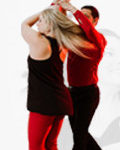One of the characteristics of west coast swing is the away connection on the anchor. But, many beginner dancers misinterpret what an away connection is, and so their upper bodies pitch back. Instead of looking graceful and solid, they instead look off-balance. Today, we’re going to fix that.
The purpose of today’s drill is to get you thinking about human movement. In general, humans are not symmetrical front to back: our spines are towards the rear of our bodies, our ribcage and pelvis come forward from the spine, and our feet stick out in front of us. Because the human body has more weight forward of the spine than behind the spine, we naturally pitch forward a couple of degrees whenever we move. This pitch has a dramatic impact on how we move forwards and backwards.
When moving forwards, the movement is initiated from a higher place because the pitch of our body causes the upper half of our body to move beyond our current base of support (i.e., the feet) first, and then we take a step in order to catch our body in a new location. If you try to go backwards from a high place, though, you’ll immediately end up off balance. Trying to move backwards from a high place is one of the key reasons that beginning dancers look off-balance and unnaturally arched back. It’s also a major factor in why beginners struggle with straightening their legs: if you pitch your upper body back, that creates a lot of stress in the lumbar spine, and the body’s natural way of compensating is to bend the knees.
So how do you fix the issue? Simple: you move backwards from a lower place.
The Drill: For this exercise, you are going to walk backwards down a set of stairs. This drill is great for teaching you to move backwards from a low place because you’ll immediately feel uncomfortable if you try to initiate your movement by taking you upper body back.
First, make sure that your stairs are clear of any potential hazards (piles, pets, or anything that might be a tripping risk). Start towards the top of the stairs and face towards the upper level. Take your time to step down a step while still facing the upward direction. You should feel like your movement starts from the somewhere near the hips.
If you’re not sure that you’re moving correctly, just try to move down from your upper body. For this, start only one step above ground level and hold onto the railing for safety. Slowly move your upper body back until you feel like you need to take a step. It should feel dramatically different, and there should be no question in your mind about which is more stable.
Go back to walking down backwards with your lower body leading. Go as slowly as you need to feel stable—this is not a speed drill. The goal is to train yourself to feel what it is like to initiate your backwards movement from a lower place. When you can do that consistently, move away from the stairs and try to move backwards on a flat floor using the same idea.
[mediacredit inline=”FALSE”]




 Brian & Megan
Brian & Megan